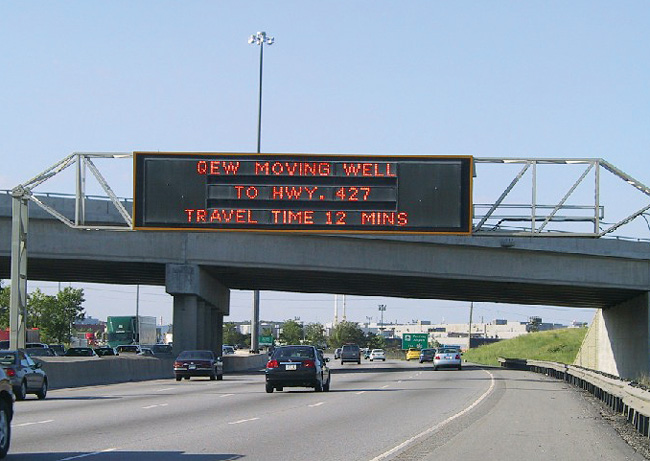2. A Framework for Describing Benefits
2.1 Anchoring Benefits to Agency Goals and Measurable Objectives
Agencies can realize "tangible benefits" (e.g., cost reductions, increased access to equipment) through a variety of actions, including arbitrary cost cutting or unfocused technology investments. However, the tangible benefits reported in this reference manual are derived from collaborative activities that help agencies achieve their goals. For example, a city public works department benefits from a collaborative effort on signal timing by participating in a joint application for Congestion Mitigation and Air Quality (CMAQ) Program funding[1] for an area-wide communications network. The network allows the city to retime its signals using fewer staff hours. In this case, the increased access to funding helps the agency achieve its goal of improving mobility on arterials, a clear benefit to the agency. Linking benefits to goals and objectives helps agencies enter into collaborative activities with an appreciation for how the arrangement benefits them.
Figure 1 depicts the connection between collaborative activities for managing a special event, some of the tangible benefits that accrue to the agency from those activities, and the agency goals that the activities support.

Figure 1. Benefits to a public safety agency participating in a collaborative effort to manage traffic during a special event.
2.2 Areas of Benefit to Individual Agencies
Agencies accrue benefits from collaborative activities in multiple ways: inputs/resources, operations, and outcomes/results (Figure 2). A benefit in the area of agency inputs or resources increases the quantity or quality of resources available for the agency to achieve its goals and objectives. This includes cost savings and increased access to funding, staff, equipment, facilities, and operating procedures.

Figure 2. Potential benefit areas for collaboration. Benefits accrue to agencies in multiple ways—greater access to better quality inputs, improvements in day-to-day operations, and better service to system users.
A second area of benefit refers to improvements in an agency's operation or functioning. Operational benefits include decreased incident verification time, increased operating hours or coverage area, new services offered, decreased funding application approval time, or increased quality of traveler information, as well as many other functions performed by the agency. This area primarily covers benefits that increase agency efficiency or productivity in day-to-day operations achieved through collaboration among agencies.
A third area of collaborative benefits encompasses the outcomes or results of the collaborative effort that bring agencies closer to achieving their goals and objectives. For example, an agency may benefit in terms of achieving its goal to reduce motorist delay (e.g., increase mobility) by implementing a signal synchronization effort that reduces delay on specific corridors.
Agencies may accrue benefits in all three benefit areas when participating in collaborative activities. For example, by participating in a multi-agency special event management effort an agency may gain access to a partner's dynamic message signs (inputs/resources benefit) that results in reduced time to clear the parking lot after the event (operations benefit), and ultimately creates increased customer satisfaction (outcome/results benefit).

Variable message sign on the Queen Elizabeth Way that links Buffalo, New York with Toronto, Ontario. (Source: Niagara International Transportation Technology Coalition)
2.3 Collaborative Strategies of Obtaining Benefits
Agencies benefit from a collaborative effort as a result of the strategies and actions they pursue together to achieve their respective goals and objectives. Many of the strategies and actions complement each other and can be used in combination. For example, a partnership may be formed to improve mobility through more timely detection and response to traffic incidents. The strategies used may begin with applying for funding by one or more agencies to support planning and implementation of improved traffic incident response capabilities, establishing area-wide communications through joint protocols and equipment standardization, acquiring technology through centralized purchasing arrangements, and establishing joint operations centers for detecting incidents and dispatching appropriate response resources.
Collaborative strategies may produce benefits that fall into one or more of the areas described in Section 2.2. Some strategies target obtaining benefits in one area; for example, "Follow the Money" or "Sharing the Wealth" strategies are designed to achieve resources benefits.
Section 3 highlights 10 collaborative strategies and actions agencies commonly use in their efforts to improve transportation systems performance. These strategies and actions to realize benefits are:
- "Follow the Money": collaborative pursuit of funding.
- "Get Smart": sharing expertise and joint learning.
- "With One Voice": coordinating communications and giving a consistent message.
- "On the Same Page": developing common procedures, protocols, and plans.
- "Measuring Up": jointly measuring performance.
- "You Ought to Know": sharing transportation information.
- "Can You Hear Me Now?": developing tools for efficient communications.
- "Sharing the Wealth": sharing resources.
- "Building Economies of Scale": consolidating services.
- "All Together Now": performing joint operations.
2.4 Benefit Measures
Agencies can use specific measures to estimate or track benefits of collaboration. Table 1 contains sample measures for identifying the benefits of collaboration that are likely the result of the typical strategies and actions shown. Benefit measures selected depend on the nature of the collaboration activity and the goals of individual agencies.
| Benefit Area | Typical Strategies & Actions | Illustrative Measure |
|---|---|---|
Inputs/Resources
|
|
|
Agency operations
|
|
|
Safety (Agency outcomes/results)
|
|
(Following measures are from U.S. Department of Transportation's ITS Evaluation Guidelines.)
|
Mobility (Agency outcomes/results)
|
|
(Following measures are from U.S. Department of Transportation's ITS Evaluation Guidelines.)
|
Efficiency (Agency outcomes/results)
|
|
(Following measures are from U.S. Department of Transportation's ITS Evaluation Guidelines.)
|
Energy and Environment (Agency outcomes/results)
|
|
(Following measures are from U.S. Department of Transportation's ITS Evaluation Guidelines.)
|
- Congestion Mitigation & Air Quality Improvement Program (CMAQ) is a categorical Federal-aid funding program that directs funding to projects that contribute to meeting National air quality standards. CMAQ funds generally may not be used for projects that result in the construction of new capacity available to SOVs (single-occupant vehicles).